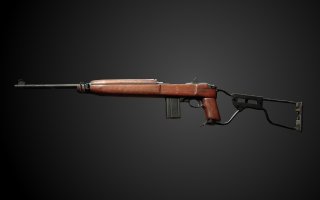Meet the M1 Carbine: America’s Answer to the German StG44
An estimated 6 million plus units were built before the carbine was retired—a pretty good service record for a somewhat underpowered plinker.
Here's What You Need to Know: As a carbine, the M1 was much more compact than the full-sized M1 Garand.
During the Second World War, the shortcoming to most countries’ standard-issue rifles became apparent. Most European and American military rifles were chambered for cartridges that were quite high-powered and not practical for the closer range that firefights normally occurred at. The United States’ service rifle during World War II was the venerable American M1 Garand, and was chambered in the powerful .30-06 round. In the hands of a skilled shooter, accurate shooting was possible past 500 yards.
However, most firefights, especially in the Pacific Theatre, took place at 300 yards or less. The M1 was both too long and too heavy, and a common troop complaint was a lack of maneuverability when using the weapon. While the Soviet Union issued the lower-powered SKS rifle, and Germany the StG44 assault rifle to give troops more firepower at these ranges, the United States also issued troops a more compact, less powerful weapon: the M1 Carbine.
.30 Carbine
The M1 Carbine was built around the .30 Carbine round. The cartridge was essentially a copy of a much older cartridge designed by Winchester around the turn of the century, though the .30 Carbine had superior performance thanks to the use of updated propellant.
Though sometimes criticized as under-powered, the .30 Carbine cartridge fell roughly in between the M1 Garand’s .30-06 cartridge and the .45 ACP cartridge used in the familiar Thompson submachine gun. Still, the .30 Carbine is easily outperformed by both the Russian AK-47 and the German StG44 assault rifles.
M1 Carbine
As a carbine, the M1 was much more compact than the full-sized M1 Garand. Initially it was issued with a folding wire stock to paratroopers, and with a fully wooden stock to artillery troops, mortarmen, drivers, other support troops, and infantry riflemen, though it was not originally intended to fill this front-line role in the same way that the M1 Garand or Thompson submachine gun did.
The carbine’s geometry was praised. It was much more maneuverable in tight urban spaces and could be more easily handled in claustrophobic jungle environments than the M1. The carbine’s small size and low weight was favored especially by soldiers or Marines that handled crew-served weapons and had to carry tripods, machine gun ammunition, or mortar parts in addition to their rifle.
One of the carbine’s main drawbacks was its relatively modest stopping power compared to the full-sized M1 Garand which easily outclassed the smallish .30 Carbine round. A number of both Army and Marine Corps post-action combat reports document instances of enemy soldiers sustaining multiple hits with the M1 Carbine before being stopped.
In response to the Germany issuing the StG44 assault rifle in ever-increasing numbers, the M1 was modified to shoot fully automatically in addition to semi-automatic, augmenting the individual rifleman’s firepower.
Postscript
Post-war, the United States exported the M1 Carbine broadly to allies in Europe, the Middle East, and Asia. In America’s own military, the M1 would serve in some capacity until replaced in the mid-1960s by the M16 rifle. An estimated 6 million plus units were built before the carbine was retired—a pretty good service record for a somewhat underpowered plinker.
Caleb Larson is a defense writer with the National Interest. He holds a Master of Public Policy and covers U.S. and Russian security, European defense issues, and German politics and culture.
This article first appeared in June 2020.
Image: Wikimedia Commons

